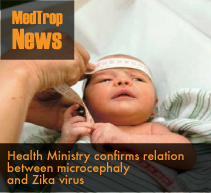
If you can not see this message correctly, click here.
Read our news in portuguese

Newsletter - Issue 53
Brazilian Society of Tropical Medicine
December 15, 2015


Aedes aegypti, cosmopolitan mosquito, vector of arboviral diseases, as yellow fever, dengue, zika and chikungunya
After the announcement by the Health Ministry confirming the relationship between the microcephaly outbreak in Brazil's Northeast and infection by Zika virus, all federative entities - Union, states and cities - have gathered efforts against the vector mosquito, the Aedes aegypti. In Pernambuco State, the Army has engaged the fight against the mosquito. These are times of caution, especially because the current focus is on pregnant women and women in reproductive age who might become pregnant in the near future.


The facts: Zika virus
Zika virus is currently Brazil's "number 1 enemy", according to the Minister of Health, Marcelo Castro. For a better understanding of the agent, doctorate students Mariana Kikuti, Igor Paploski e Laura Tauro, along with Fiocruz-BA researcher Dr. Guilherme Ribeiro, built a Q&A about the theme.

Mosquito-borne chikungunya virus causes severe brain inflammation
New Ebola case emerges in Liberia months after eradication
America’s War on the Kissing Bug
Virus creates an outbreak children born with microcephaly in Brazil
Brazil reports the first death by Zika
Having HIV is not the same as having AIDS; see myths and truths



The new treatment could enhance these people's lives by repairing their immune systems
Combining antiretroviral therapy with a protein known as Interleukin 21 (IL-21) provided promising results in monkeys infected with SIV, a virus equivalent to HIV in humans. This is the result of a research, published on November's edition of the Journal of Clinical Investigation. According to the researchers, combining antiretroviral treatment with...

Eliminating hidden HIV-infected cells would limit the dependence on antiretroviral drugs
Eliminating HIV from the human body is one of science's current obsessions. Among the approaches towards this goal is the attempt to annihilate the "dormant" infected cells, which are invisible to the immune system and antiviral drugs. In addition, a study in this course seems to be close to success. Researchers at the National Institute of Health, USA have created, in laboratory, a protein - called VRC07-αCD3 - able to mark cells infected by the virus, easing its...

Below is a selection of for this month of december of publications related to Tropical Medicine from important international journals.
Malignant Transformation of Hymenolepis nana in a Human Host
An obscure mosquito-borne disease goes global



Crack's diffusion through poor regions, since they are more vulnreable, owes to the cheap price, easy portability and is sold in retail
Derived from cocaine base paste, crack has been used by approximately two million people in Brazil, according to a recent study by Lenad (National Survey on Alcohol and Drugs).


Of 7 November 2015 the February 15, 2016
Competition for associate professor in the Department of Parasitology of UFMG
Of November 16, 2015 the January 19, 2016
Professor in infectious and parasitic diseases, IPTSP / UFG
Brazilian Society of Tropical Medicine - Center for Tropical Medicine - UnB
Hours: Monday to Friday from 8am to 12pm and from 14pm to 18pm
sbmt@sbmt.org.br | PO Box 4356 | Room 43C - 70904-970 | Brasilia - DF | Phone/Fax: (61) 3307-1154